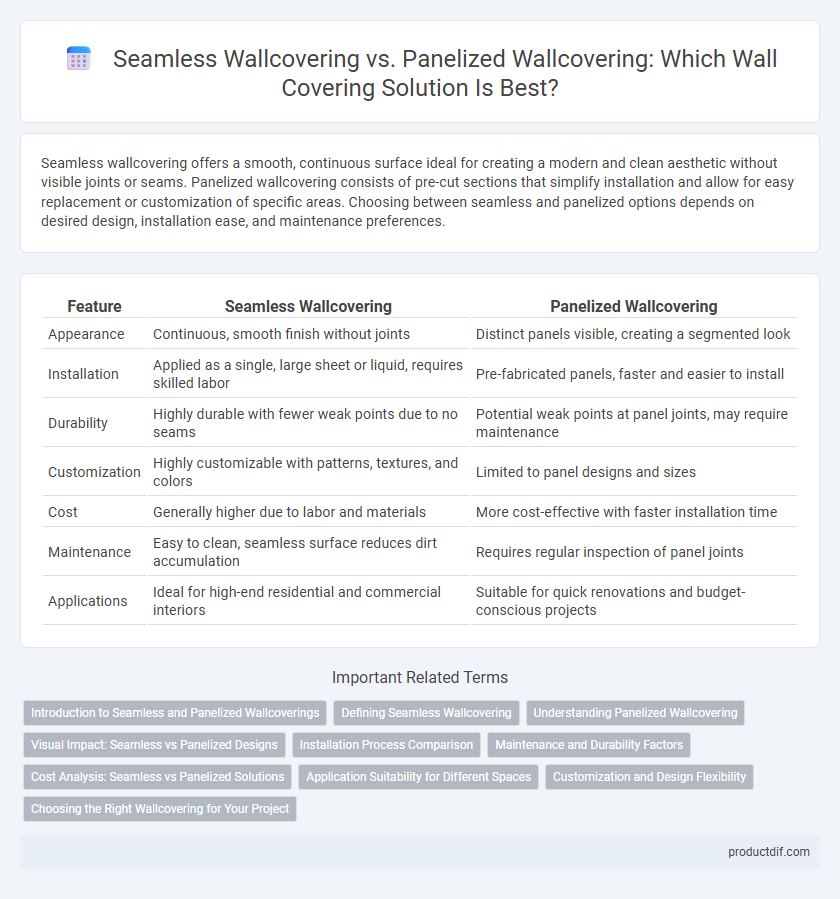Seamless wallcovering offers a smooth, continuous surface ideal for creating a modern and clean aesthetic without visible joints or seams. Panelized wallcovering consists of pre-cut sections that simplify installation and allow for easy replacement or customization of specific areas. Choosing between seamless and panelized options depends on desired design, installation ease, and maintenance preferences.
Table of Comparison
| Feature | Seamless Wallcovering | Panelized Wallcovering |
|---|---|---|
| Appearance | Continuous, smooth finish without joints | Distinct panels visible, creating a segmented look |
| Installation | Applied as a single, large sheet or liquid, requires skilled labor | Pre-fabricated panels, faster and easier to install |
| Durability | Highly durable with fewer weak points due to no seams | Potential weak points at panel joints, may require maintenance |
| Customization | Highly customizable with patterns, textures, and colors | Limited to panel designs and sizes |
| Cost | Generally higher due to labor and materials | More cost-effective with faster installation time |
| Maintenance | Easy to clean, seamless surface reduces dirt accumulation | Requires regular inspection of panel joints |
| Applications | Ideal for high-end residential and commercial interiors | Suitable for quick renovations and budget-conscious projects |
Introduction to Seamless and Panelized Wallcoverings
Seamless wallcoverings offer a continuous, unbroken surface that enhances modern interior aesthetics by minimizing visual interruptions and making spaces appear larger. Panelized wallcoverings consist of pre-cut sections or panels that allow for easier installation and pattern alignment, offering flexibility in design and maintenance. Both types cater to different design preferences and functional needs, with seamless focusing on uniformity and panelized on customization.
Defining Seamless Wallcovering
Seamless wallcovering refers to a continuous, unbroken expanse of material applied directly to walls, offering a smooth, uniform appearance without visible joints or seams. This type of wall treatment is favored for its ability to create a sleek, modern aesthetic and is often made from materials such as liquid wallpaper, fabric, or vinyl. Seamless wallcoverings enhance durability and ease of cleaning while minimizing moisture infiltration, making them ideal for high-traffic or humid environments.
Understanding Panelized Wallcovering
Panelized wallcovering consists of pre-cut sections designed for precise installation, offering enhanced durability and ease of maintenance compared to seamless options. These panels allow for complex patterns and textures to be aligned perfectly, reducing visible seams and improving overall aesthetic appeal. Ideal for commercial and high-traffic areas, panelized wallcoverings provide efficient replacement of damaged sections without disturbing adjacent areas.
Visual Impact: Seamless vs Panelized Designs
Seamless wallcoverings create a continuous visual effect by eliminating visible joints, enhancing the sense of space and sophistication in a room. Panelized wallcoverings, with distinct segments, can introduce texture and rhythm but may interrupt the overall design flow, affecting perception and aesthetic cohesion. Choosing between seamless and panelized options depends on desired visual impact and architectural style integration.
Installation Process Comparison
Seamless wallcovering installation involves applying a continuous roll of material, requiring precise alignment to avoid visible joints, while panelized wallcovering consists of pre-cut panels that simplify positioning and reduce installation time. Seamless installations demand skilled craftsmanship for smooth adhesion and wrinkle-free surfaces, whereas panelized options allow for easier handling and faster replacement of damaged sections. Both methods require surface preparation, but panelized wallcovering often minimizes disruption in high-traffic areas due to its modular nature.
Maintenance and Durability Factors
Seamless wallcoverings offer superior durability due to the absence of joints, reducing wear and tear and minimizing the risk of peeling or cracking over time, making maintenance easier and less frequent. Panelized wallcoverings, while allowing for intricate designs and easier section replacement, tend to accumulate dirt and damage along the seams, increasing maintenance efforts and potential repair costs. Both types benefit from materials like vinyl or fiberglass for enhanced longevity, but seamless options notably outperform in maintaining a flawless appearance under heavy use or in high-traffic areas.
Cost Analysis: Seamless vs Panelized Solutions
Seamless wallcovering typically involves higher upfront labor costs due to intricate installation processes requiring skilled professionals, whereas panelized wallcovering offers more predictable expenses with pre-cut panels that simplify installation and reduce time. Material costs for seamless options may be elevated because of custom fabrication and the use of continuous substrates, while panelized systems benefit from standardized materials that often lower overall expenditure. Long-term maintenance and repair costs favor seamless wallcoverings for their uninterrupted surface that minimizes dirt accumulation and damage, contrasting with panelized wallcoverings that might incur additional expenses at panel joints.
Application Suitability for Different Spaces
Seamless wallcoverings provide a smooth, continuous surface ideal for large, open spaces like hotels, hospitals, and commercial lobbies where a clean, uninterrupted aesthetic is desired. Panelized wallcoverings are better suited for smaller rooms, feature walls, or areas requiring frequent repairs and replacements due to their modular design and ease of installation. The choice depends on the need for durability, maintenance, and visual impact tailored to specific environments.
Customization and Design Flexibility
Seamless wallcovering offers unparalleled customization, allowing for continuous, uninterrupted designs that can be tailored to fit unique wall dimensions and complex architectural features. Panelized wallcovering provides design flexibility through modular installation, enabling easy replacement of individual sections and varied pattern configurations. Both options support bespoke aesthetics, but seamless solutions excel in achieving a cohesive, fluid visual effect without visible joins.
Choosing the Right Wallcovering for Your Project
Seamless wallcovering offers a smooth, continuous surface ideal for large, modern spaces demanding minimal visual interruption and easy maintenance. Panelized wallcovering provides versatility through distinct sections, perfect for creating patterned designs or accommodating irregular wall dimensions. Selecting the right option depends on the project's aesthetic goals, wall structure, and installation requirements to ensure durability and visual appeal.
Seamless Wallcovering vs Panelized Wallcovering Infographic

 productdif.com
productdif.com